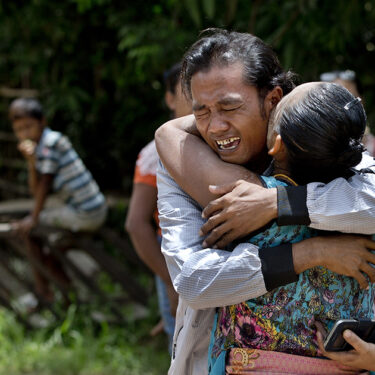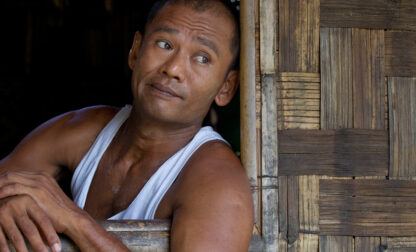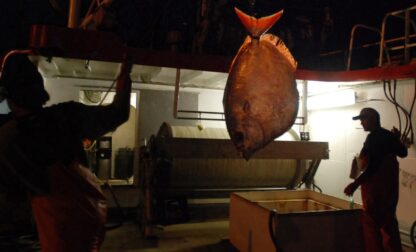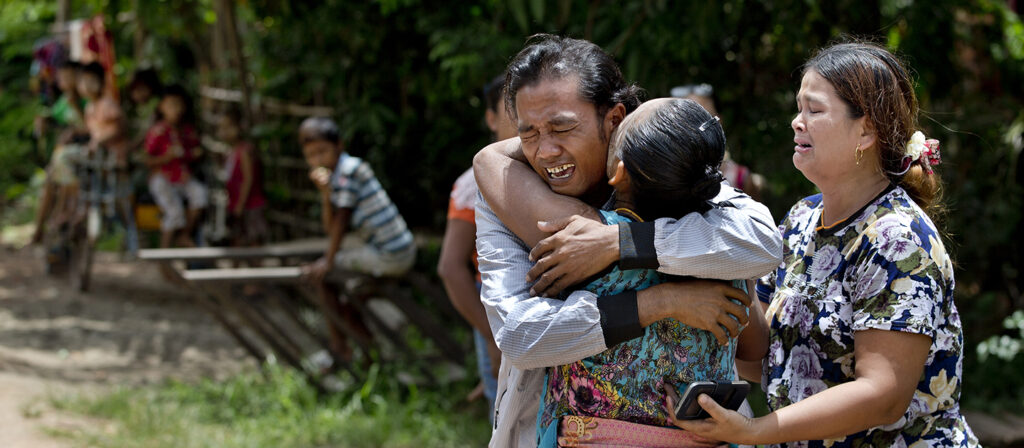
UAL, Indonesia — All he did was ask to go home.
The last time the Burmese slave made the same request, he was beaten almost to death. But after being gone eight years and forced to work on a boat in faraway Indonesia, Myint Naing was willing to risk everything to see his mother again. His nights were filled with dreams of her, and time was slowly stealing her face from his memory.
So he threw himself on the ground and roped his arms around the captain’s legs to beg for freedom.
The Thai skipper barked loud enough for all to hear that Myint would be killed for trying to abandon ship. Then he flung the fisherman onto the deck and chained down his arms and legs.
Myint was left for three days to burn in the searing sun and shiver in the nighttime rain, without food or water. He wondered how he would be killed. Would they throw his body overboard to wash up on shore, like the other corpses he’d seen? Would they shoot him? Or would they simply bash his head open, as they had done before?
He was never going to see his mother again. He would simply disappear, and she wouldn’t even know where to look.
Every year, thousands of migrant workers like Myint are tricked or sold into the seafood industry’s gritty underworld. It’s a brutal trade that has operated for decades as an open secret in Southeast Asia’s waters, where unscrupulous companies rely on slaves to supply fish to major supermarkets and stores worldwide.
As part of a year-long investigation into the multibillion-dollar business, The Associated Press interviewed more than 340 current and former slaves, in person or in writing. The stories told by one after another are strikingly similar.
Myint is a thin, soft-spoken man with the wiry strength of someone who has worked hard all his life. Illness has left his right arm partly paralyzed and his mouth clenched into a forced half-smile. But when he breaks into laughter, you see flashes of the boy he once was, despite all that has happened in between — a 22-year odyssey recounted by Myint and his relatives.
He comes from a small village off a narrow, dusty road in southern Myanmar’s Mon State, the oldest of four boys and two girls. In 1990, his father drowned while fishing, leaving him as the man in charge at just 15. He helped cook, wash clothes and care for his siblings, but they kept sliding deeper into poverty.
So when a fast-talking broker visited the neighborhood three years later with stories of jobs in Thailand, Myint was easily wooed. The agent offered $300 for just a few months of work — enough for some families to survive on for a year. He and several other young men quickly put their hands up to go.
His mother, Khin Than, wasn’t so sure. He was only 18 years old, with no education or travel experience. But he kept begging, arguing that he wouldn’t be gone long and relatives already working there could look after him.
Finally, she relented.
Neither of them knew it but, at that moment, Myint began a journey that would take him thousands of miles away from his family. He would miss births, deaths, marriages and the unlikely transition of his country from a dictatorship to a bumpy democracy. He would run away twice from the ruthless forced labor on a fishing boat, only to realize that he could never escape from the shadow of fear.
Yet on the day he left home in 1993, all Myint saw was promise. The broker hustled his new recruits to grab their bags immediately, and Myint’s 10-year-old sister wiped tears from her cheeks as she watched him walk down the dirt track away from their village.
His mother wasn’t home. He never got to say goodbye.
Thailand earns $7 billion a year from a seafood industry that runs on labor from the poorest parts of the country, along with Cambodia, Laos and especially Myanmar, otherwise known as Burma. Up to 200,000 estimated migrants, most of them illegal, work at sea. Their catch ends up halfway around the globe in the United States, Europe and Japan — on dinner tables and in cat food bowls.
As overfishing decimates stocks near Thailand’s shores, trawlers have been forced to venture farther and farther into more plentiful foreign waters. The dangerous work keeps men at sea for months or even years with fake Thai identity documents, trapped aboard floating prisons run by captains with impunity. Though Thai officials deny it, they have long been accused of turning a blind eye to such practices.
After easily skirting police at the border with Thailand and being held in a small shed with little food for more than a month, Myint was shoved onto a boat. The men were at sea for 15 days and finally docked in the far eastern corner of Indonesia. The captain shouted that everyone on board now belonged to him, using words Myint would never forget:
“You Burmese are never going home. You were sold, and no one is ever coming to rescue you.”
He was panicked and confused. He thought he would be fishing in Thai waters for only a few months. Instead the boys were taken to the Indonesian island of Tual in the Arafura Sea, one of the world’s richest fishing grounds, stocked with tuna, mackerel, squid, shrimp and other lucrative species for export.
Myint spent weeks at a time on the open ocean, living only on rice and the parts of the catch no one else would eat. During the busiest times, the men worked up to 24 hours a day, hoisting heavy nets rippling with fish. They were forced to drink foul-tasting boiled sea water.
“You Burmese are never going home. You were sold, and no one is ever coming to rescue you.”
He was paid only $10 a month, and sometimes not at all. There was no medicine. Anyone who took a break or fell ill was beaten by the Thai captain, who once lobbed a piece of wood at Myint for not moving fish fast enough.
Nearly half the Burmese men surveyed by the AP said they were beaten, or witnessed others being abused. They were made to work almost nonstop for nearly no pay, with little food and unclean water. They were whipped with toxic stingray tails, shocked with Taser-like devices and locked in a cage for taking breaks or attempting to flee. Sometimes, the men said, the bodies of those who died were stashed in the ship’s freezer alongside the fish.
Workers on some boats were killed for slowing down or trying to jump ship. The Burmese fishermen said others flung themselves overboard because they saw no escape. Myint spotted several bloated bodies floating in the water.
By 1996, after three years, he had had enough. Penniless and homesick, he waited until his boat returned to Tual. Then he went into the office on the dock and, for the first time, asked to go home.
His request was answered by a helmet cracking his skull. As blood oozed out, he used both hands to hold the wound together. The Thai man who hit him repeated the words that already haunted him:
“We will never let you Burmese fishermen go. Even when you die.”
That was the first time he ran away.
On islands scattered throughout the Maluku chain in Indonesia, also known as the Spice Islands, thousands of migrant fishermen who have escaped or been abandoned by their captains quietly hide out in the jungle. Some start families with local women, partly to protect themselves from slave catchers. It’s risky, but one of the only ways to find a semblance of freedom.
An Indonesian family took mercy on Myint until he healed, and then offered him food and shelter in exchange for work on their farm. For five years, he lived this simple life and tried to erase memories of the horrors at sea. He learned to speak the Indonesian language fluently and acquired a taste for the food, even though it was much sweeter than the salty Burmese dishes his mother fixed.
But he couldn’t forget his relatives in Myanmar or the friends he left behind on the boat. What happened to them? Were they still alive?
Sometimes Myint quietly visited other runaway Burmese slaves on the island to talk about home, bringing a big bag of vegetables he grew himself.
“He was a bit afraid to go around,” remembered Naing Oo, another former Burmese slave in Tual. “It was very brutal on the fishing boats.”
In the meantime, the world around him was changing. By 1998, Indonesia’s longtime dictator Suharto had fallen, and the country was moving toward democracy. Myint wondered if maybe things were getting better on the ships too.
In 2001, he heard one captain was offering to take fishermen back to Myanmar if they agreed to work. He was determined to find a way home. So, eight years after he first arrived in Indonesia, he returned to the sea.
Right away, he knew he’d fallen into the same trap again. The work and conditions were just as appalling as the first time, and the money still didn’t come.
If anything, the slavery was getting worse. Thailand was rapidly becoming one of the world’s biggest seafood exporters, and needed more cheap labor. Brokers deceived, coerced or sometimes even drugged and kidnapped migrant workers, including children, the sick and the disabled.
After nine months on the water, Myint’s captain broke his promise and told the crew he was abandoning them to go back to Thailand alone.
Furious and desperate, the Burmese slave once again pleaded to go home. That, he said, was when the captain chained him to the boat for three days.
Myint searched wildly for something, anything, to open the lock. Working it with his fingers was useless. Then he managed to fashion a small piece of metal into a makeshift pick and spent hours trying to quickly and quietly unlatch freedom. Finally, there was a click. The shackles slid off. He knew there wasn’t much time, and if he got caught, death would come swiftly.
Sometime after midnight, he dove into the black water and swam to shore. Then he ran without looking back, in clothes still weighted by sea water.
He knew he had to disappear. This time, for good.
The slave trade in the Southeast Asian seafood industry is remarkable in its resilience. Over the past decade, outsiders have begun to take notice, and the U.S. government slams Thailand in annual reports year after year for pervasive labor abuses in fishing. Yet it continues, and it seldom lets go of the lives of those it ruins.
After he ran the second time, Myint hid alone in a bamboo shack in the jungle. But just three years later, he fell ill with what appeared to be a stroke. His nerves seemed to stop firing properly, leaving him easily chilled despite the oppressive tropical heat.
When he became too sick to work, the same Indonesian family cared for him with a kindness that reminded him of relatives back home. He had forgotten what his mother looked like, and knew that by now his favorite little sister would be all grown up. They likely thought he was dead.
What he didn’t know was that his mother was like him: She never gave up. She prayed for him every day at the little Buddhist altar in her family’s traditional stilt house, and asked fortune tellers year after year about her son. They assured her he was alive, but in a faraway place difficult to leave.
At one point, another Burmese man told the family that Myint was fishing in Indonesia and married. But Myint never wanted to be tethered to the country that had destroyed his life.
“I didn’t want an Indonesian wife, I just wanted to go back home to Myanmar,” he said. “I felt like I lost my young man’s life. I just thought that all of this time, I should have been in Burma having a wife and a proper family.”
After eight more years in the jungle without a clock or calendar, time began to blur. Now in his 30s, he started to believe the captain had been right: There really was no escape.
He couldn’t go to the police or local officials, afraid they might hand him over to the captains for a fee. He had no way to call home. And he was scared to contact the Myanmar embassy because it would expose him as an illegal migrant.
In 2011, the solitude had become too much. Myint moved to the island of Dobo, where he had heard there were more Burmese. He and two other runaway slaves farmed chilies, eggplant, peas and beans until the police arrested one in the market and put him back on a boat. The man later fell sick at sea and died.
It was yet another reminder to Myint that if he wanted to survive, he needed to do it carefully.
One day in April, a friend came to him with news: An AP report linking slavery in the seafood industry to some of the biggest American grocery stores and pet food companies had spurred the Indonesian government to start rescuing current and former slaves on the islands. To date, more than 800 have been found and repatriated.
This was his chance. When the officials came to Dobo, he went back with them to Tual, where he was once a slave — this time to join hundreds of other free men.
After 22 years in Indonesia, Myint was finally going home. But what, he wondered, would he find?
It was yet another reminder to Myint that if he wanted to survive, he needed to do it carefully.
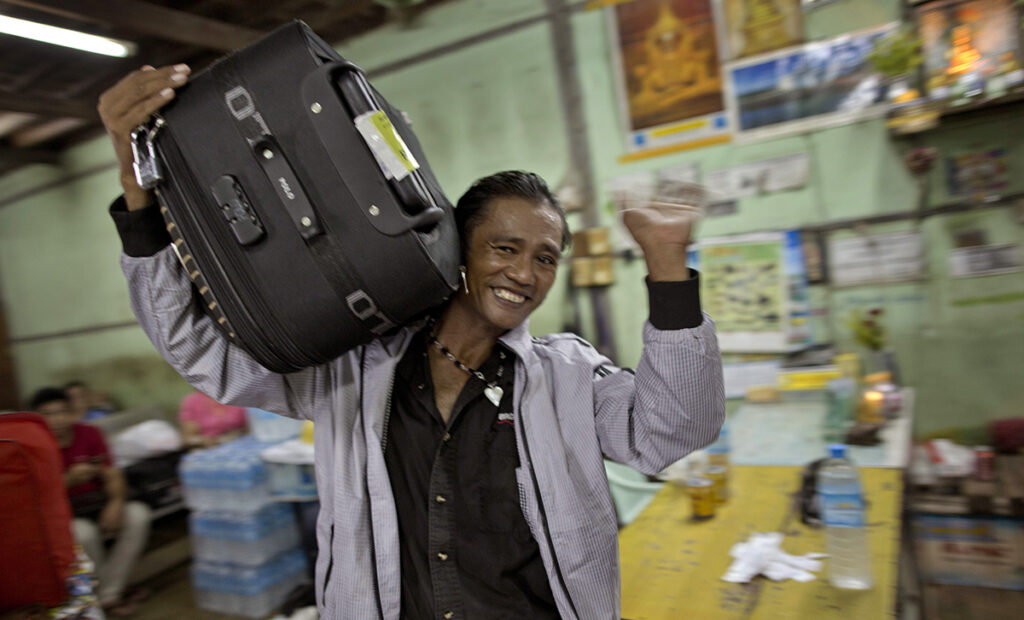
The flight from Indonesia to Myanmar’s biggest city, Yangon, was a terrifying first for Myint. He walked out of the airport with a small black suitcase and a donated hat and shirt — all he had to show for his long time abroad.
Myint was coming back a stranger to his own country. Myanmar was no longer ruled by a secretive military government, and opposition leader Aung San Suu Kyi was free from years of house arrest and in Parliament.
The currency was baffling. He struggled to convert 15,000 Indonesian rupiah into about 1,000 Myanmar kyat, both roughly $1.
“I feel like a tourist,” he said, sweat dripping down his face and chest. “I feel Indonesian.”
The food was different, and so were the greetings. Myint kept shaking hands and touching his heart the Indonesian way, instead of bowing with his hands in a prayer position like a Burmese.
Even the words seemed odd. While he waited with other former slaves for the bus to Mon State, they chatted not in their native Burmese, but in Bahasa Indonesia.
“I don’t want to speak that language anymore because I suffered so much there,” he said. “I hate that language now.” Yet he continued to slip in and out of it.
Most of all, just as the country had changed, so had he. He had left as a boy, but was returning a 40-year-old man who had been enslaved or in hiding for more than half his life. And he was the only one from his village to come back at all.
When he reached his home state, Myint’s emotions started to fray. He was too nervous to eat. He fidgeted, running his hands through his hair and constantly rubbing the heart-shaped abalone pendant around his neck. Finally, it all became too much, and he started to sob.
“My life was just so bad that it hurts me a lot to think about it,” he choked out. “I miss my mom.”
He wondered if he would even recognize his mother and sister, or if they would remember him.
An hour later, he slapped his head in frustration as he tried to remember which way to go. The roads were now paved and lined with new buildings. He rubbed his palms on his pants and squirmed in excitement when he recognized a police station. He knew he was close.
Finally, the car he was riding in turned into a small village. He called a phone number that he had gotten only the day before. Seconds later, when he saw a plump Burmese woman — on the same road that had led him away so many years ago — he knew immediately it was his little sister.
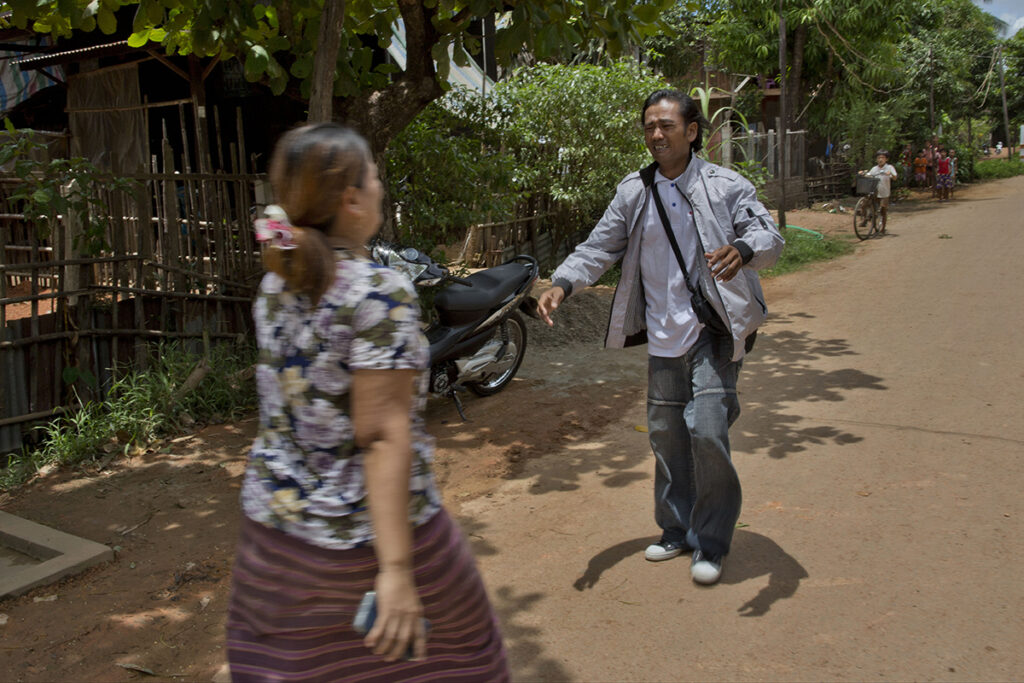
They exploded into an embrace, and the tears that spilled were of joy and mourning for all the lost time apart. “Brother, it’s so good that you are back!” she sobbed. “We don’t need money! We just need family! Now you are back, it’s all that we need.”
But his mother was missing. Myint anxiously scanned the road as his sister frantically dialed a number.
And then a small, frail figure with gray-streaked hair began to run.
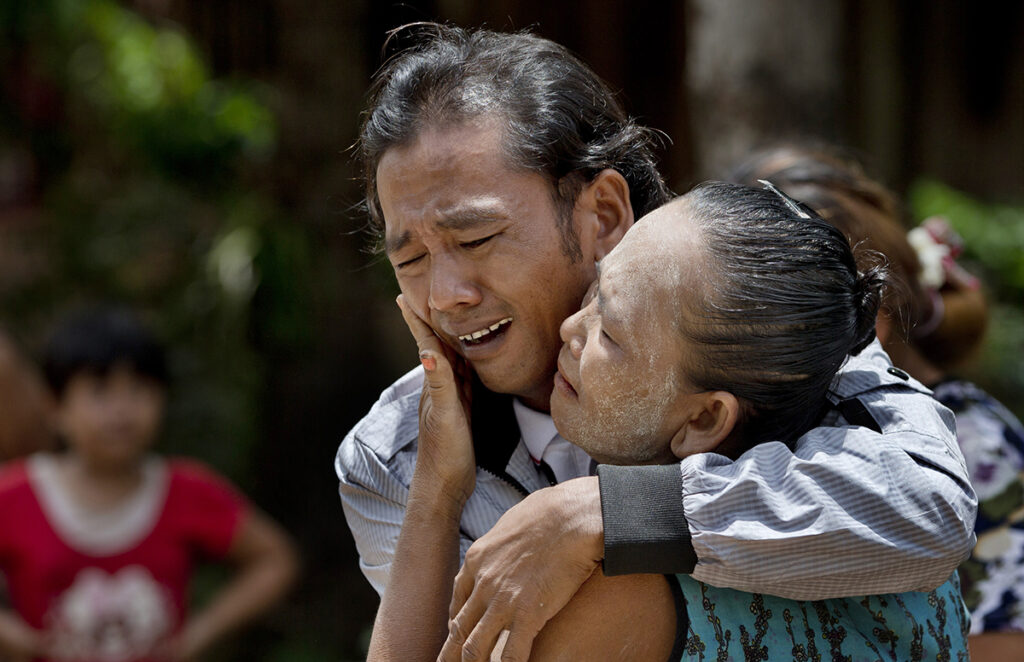
When he spotted her, he howled and fell to the ground, burying his face in his hands. She swept him up in her arms and softly stroked his head, cradling him as he let everything go.
They wailed and wept so loudly, the whole village emerged to see what seemed like a ghost. “That guy’s been gone for 20 years,” one man said.
Myint, his mother and his sister walked arm-in-arm to the simple stilt house of his childhood. At the front gate, he crouched on his knees, and they heaved water with a traditional tamarind soap on his head to cleanse away evil spirits.
As his sister helped wash his hair, his 60-year-old mother turned pale and collapsed against a bamboo ladder. Then, suddenly, she grabbed her heart and began to gasp for air. Relatives and neighbors fanned her and fetched water and a lime to smell, but her eyes rolled back into her head. Someone yelled that she wasn’t breathing.
Myint ran to her, dripping wet, and blew three breaths into her mouth.
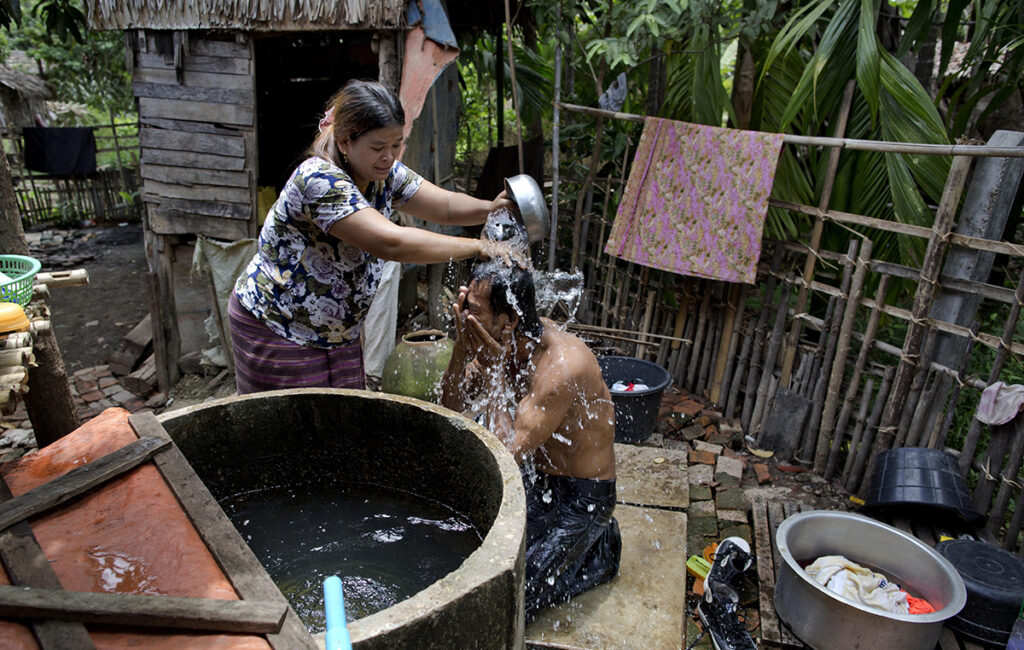
“Open your eyes! Open your eyes!” he screamed, beating his chest with both hands. “I’ll look after you from now on! I will make you happy! I don’t want to see you sick! I am back home!”
She slowly revived, and Myint took a long look into her eyes.
He was finally free to see the face from his dreams. He would never forget it again.
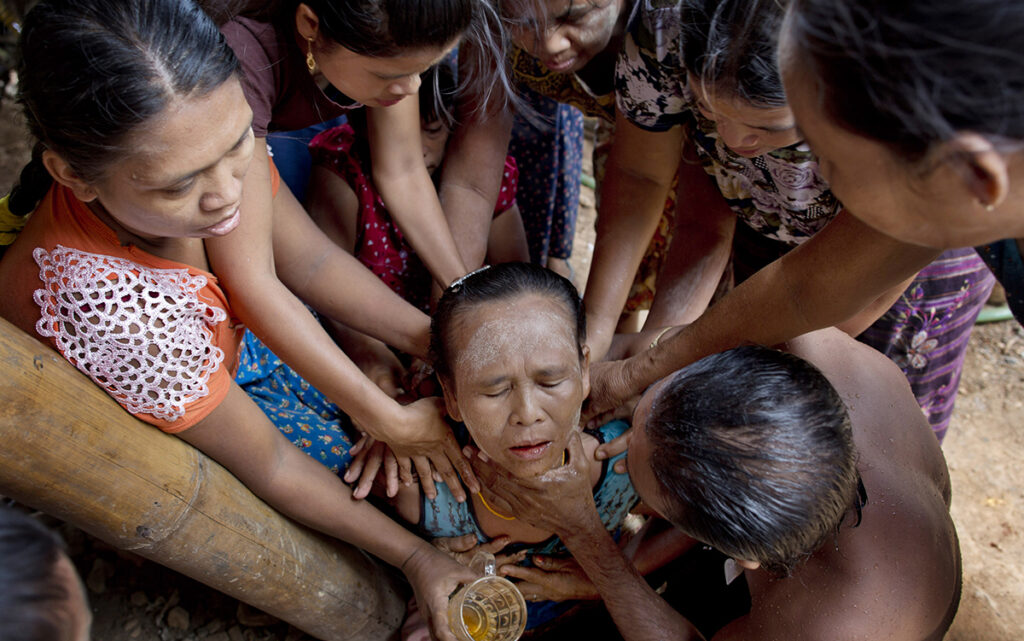
WHERE THIS STORY CAME FROM
Myint Naing’s story comes from interviews with him, his family, his friends and other former slaves, and through following his journey from a makeshift camp set up for rescued men at an Indonesian port in Tual, Indonesia, to his home in Myanmar. He’s among hundreds rescued and returned to their families after a year-long AP investigation exposed extreme labor abuses in Southeast Asia’s seafood industry. Reporters documented how slave-caught fish is shipped from Indonesia to Thailand. It can then be exported to the United States and cloud the supply chains of supermarkets and distributors, including Wal-Mart, Sysco and Kroger, and pet food brands, such as Fancy Feast, Meow Mix and Iams. The companies have all said they strongly condemn labor abuse and are taking steps to prevent it.

